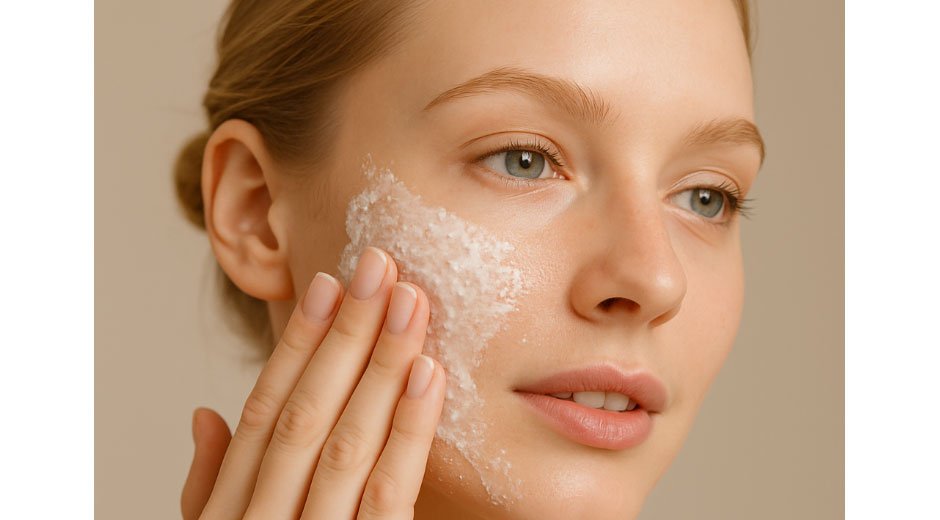The Importance of Keratolytic Action and pH
Why Is Exfoliation Necessary?
Dead keratinocytes accumulate regularly on the surface of the skin. While the stratum corneum plays a protective role, excessive buildup can lead to rough skin texture, a dull appearance, and hindered absorption of skincare products. Especially during seasonal changes or when skin condition deteriorates, keratin becomes more prone to lifting or clumping. For these reasons, exfoliation tailored to the skin type and condition is a crucial step in maintaining healthy and smooth skin.
Types of Exfoliation Methods
Exfoliation is broadly categorized into physical methods (scrubs, brushes, etc.) and chemical methods (dissolution by active ingredients). Recently, chemical exfoliants that effectively dissolve dead skin cells while minimizing irritation have gained popularity.
Understanding Chemical Exfoliating Ingredients
- AHA (Alpha Hydroxy Acid):A representative water-soluble exfoliant that includes glycolic acid, lactic acid, malic acid, citric acid, and tartaric acid. These ingredients gently dissolve surface keratin and also provide moisturizing effects. AHAs are particularly suitable for dry and aging skin.
- BHA (Beta Hydroxy Acid):Salicylic acid is the most well-known BHA. It is oil-soluble and penetrates into pores to dissolve sebum and keratin, making it effective for blackheads, excess oil, and acne-prone skin. Recommended for oily and acneic skin types.
- PHA (Polyhydroxy Acid):Includes gluconolactone and lactobionic acid. PHAs have larger molecular structures than AHAs, resulting in slower skin penetration and lower irritation. Ideal for sensitive and dry skin types.
- LHA (Lipo Hydroxy Acid):A derivative of BHA, LHA is oil-soluble but gentler, providing exfoliation and calming effects. Suitable for sensitive and breakout-prone skin.
- Enzymes:Natural enzymes such as papain and bromelain remove dead skin cells by breaking down proteins. Because they cause minimal physical irritation, enzyme-based exfoliants are primarily used for sensitive skin.
Exfoliant Selection Guide by Skin Type
- Oily and Acne-Prone Skin:Due to sebum and keratin clogging pores, salicylic acid (BHA) and LHA are effective. These ingredients penetrate deeply into pores to dissolve impurities and help prevent acne.
- Dry and Aging Skin:For skin that tends to feel rough or flaky, glycolic acid and lactic acid (AHAs) are appropriate. These ingredients provide both exfoliation and hydration, resulting in smoother texture.
- Sensitive Skin:PHA, LHA, and enzyme-based exfoliants with low irritation levels are preferred. Although the exfoliating effect is milder, they minimize the risk of barrier damage.
- Combination Skin:Use BHA for the T-zone (forehead and nose) and AHA or PHA for the U-zone (cheeks and chin). A tailored combination of ingredients by area is most effective.
Mechanism of Keratolytic Action
Chemical exfoliants weaken intercellular adhesions (corneodesmosomes) in the stratum corneum or break down keratin proteins to facilitate natural desquamation. For example, AHAs disrupt cell cohesion, BHAs bind with sebum to dissolve pore-clogging debris, and enzymes selectively degrade keratin proteins with minimal irritation.
Effectiveness of Exfoliating Ingredients and the Role of pH
The efficacy of exfoliating agents is heavily influenced by the pH of the product. Most chemical exfoliants are activated in acidic environments.
- Optimal pH for AHA and BHA:Generally, pH 3–4 provides maximal keratolytic activity. As the pH increases (closer to neutral), the exfoliating effect diminishes. However, a pH that is too low can cause irritation, so for sensitive skin, products with a pH of 4–5 are advisable.
- pH Range for PHA and LHA:PHAs and LHAs remain stable and effective at a slightly higher pH (4–5), making them suitable for sensitive skin. They provide gentle exfoliation with minimal irritation.
Normal Skin pH and Exfoliation Balance
Healthy stratum corneum maintains a slightly acidic pH of 4.5–5.5. This acid mantle strengthens the skin barrier, suppresses pathogenic bacteria, and supports the synthesis of natural moisturizing factors and intercellular lipids. Using alkaline cleansers or inappropriate exfoliants can raise the skin’s pH, weakening the barrier and triggering dryness, breakouts, and sensitivity.
pH Checkpoints When Using Exfoliating Products
- Choose pH 3–4 products for strong exfoliating effects, and pH 4–5 for gentler formulations if irritation is a concern.
- Rinse with lukewarm water after exfoliation to help restore skin’s pH balance.
- Use slightly acidic cleansers, toners, and moisturizers to aid in skin barrier recovery.
Comparison of Exfoliating Ingredients
| Ingredient | Solubility | Primary Site of Action | Irritation Level | Suitable Skin Types |
| Glycolic Acid (AHA) | Water-soluble | Skin surface | Moderate to high | Dry, aging, combination |
| Lactic Acid (AHA) | Water-soluble | Skin surface | Moderate | Dry, sensitive |
| Salicylic Acid (BHA) | Oil-soluble | Pores, sebum | Moderate | Oily, acne-prone, combination |
| Gluconolactone (PHA) | Water-soluble | Skin surface | Low | Sensitive, dry |
| LHA | Oil-soluble | Pores, skin surface | Low | Sensitive, breakout-prone |
| Enzymes | — | Skin surface | Very low | Sensitive, all skin types |
Importance of Post-Exfoliation Care
Because exfoliation can temporarily irritate the skin, post-care is essential. After exfoliating, apply a generous amount of moisturizer to protect the skin barrier and use sunscreen to guard against external aggressors. The frequency of exfoliation should be limited to 1–2 times per week, depending on skin type and product strength.
Practical Exfoliation Tips by Skin Type
- Oily/Acne-Prone Skin: Use BHA or LHA ingredients regularly in the evening skincare routine and avoid excessive physical exfoliation.
- Dry/Aging Skin: Choose mild exfoliating products containing AHA or PHA, and apply rich moisturizers after exfoliation.
- Sensitive Skin: Use PHA or enzyme exfoliants less than once a week. Discontinue use if redness or stinging occurs.
- Combination Skin: Customize exfoliants by facial area or use low-irritation products in small amounts multiple times.
Balancing Exfoliation, pH, and Barrier Repair
Effective exfoliation requires a proper match between ingredients and skin type, careful pH management, and appropriate post-care for barrier restoration. Selecting the right exfoliant for your skin and maintaining pH balance are key to achieving healthy, radiant skin. Adjusting your exfoliation routine based on skin condition, season, and lifestyle will help you maintain smooth and resilient skin without irritation.










